Scott AFB, Alton VFW present ‘Badge of Courage’to 6-year-old Hayden Brown
Bellville News-Democrat, Scott AFB News, 26 Aug 2016
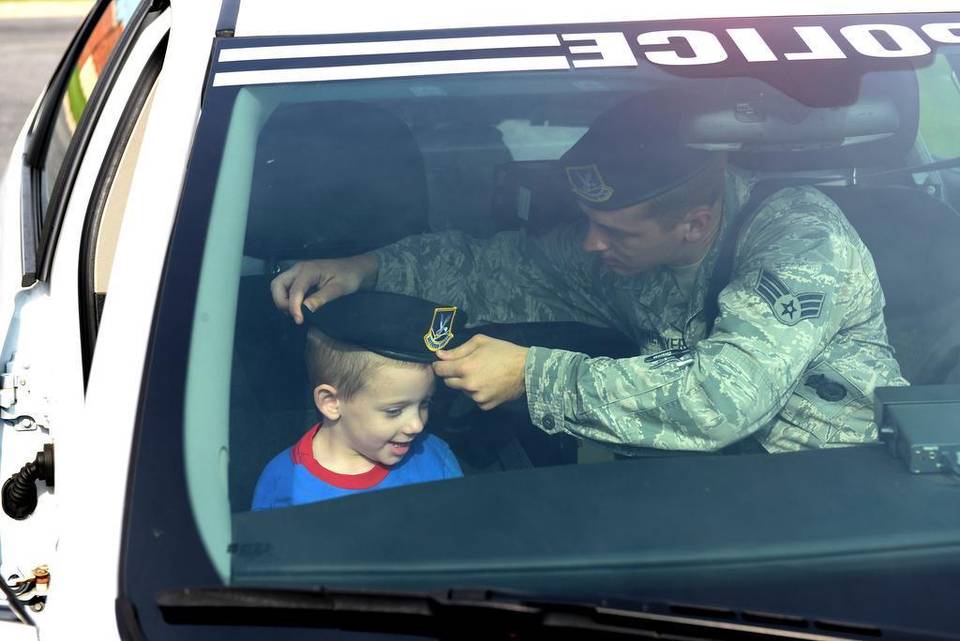
Senior Airman Sheldon Timmermeyer, 375th Security Forces Squadron, got the day started with his new friend Hayden who helped provide the police escort to their first destination of the day. Timmermeyer also helped to coordinate volunteers who played Batman and Joker for the event scenario for which Hayden helped the Airmen to track down. Photo by Senior Airman Megan Friedl
By Senior Airman Megan Friedl, 375th Air Mobility Wing Public Affairs
Little 6-year-old Hayden Brown doesn’t get to do what most children his age do because of a rare terminal degenerative disease called Metachromatic Leukodystrophy, commonly referred to as MLD. This condition makes it difficult for him to eat, walk, talk and even show facial expressions.
In recent months, there’s been a rapid decline in Hayden’s health, so in a race to beat the effects of MLD, his father, Jonathan, began working to provide him with as many wonderful childhood memories as he possibly can. They’ve come up with a bucket list of activities, and friends and family are rallying to help Hayden do simple pleasures of life like go camping or ride in a race car.
Recently, Jonathan reached out to Alton’s VFW Post 1308 when he heard about an award they give to children called the “Badge of Courage.” Created by Wayne Able and William Perkins, the Badge of Courage is a way to honor children who show courage and determination through an illness, and they’ve presented medals to numerous children in hospital rooms for the past few years.
The VFW reached out to the Airmen of the 375th Air Mobility Wing to see if they could assist in creating a special event for Hayden, which resulted in developing a “Pilot for a Day” program that included a formal presentation of the medal to him.
“When we heard about this opportunity, we were really excited about supporting this,” said Maj. Geoffrey Ashby, 458th Airlift Squadron assistant operations officer. “More than 30 volunteers came together to give him a day he would remember. Because we knew he likes superheroes, especially Batman, our team created a scenario where Hayden would help the Batman catch the Joker who was eluding us. He was given an assignment and intel brief, trained, given his wings, sat in the cockpit of our C-21 and then helped Batman catch the Joker at the end of the day. Our team got him a flight suit, name tag, hat and captain bars for his assignment, so he would truly be one of us for the day.”
Senior Airman Sheldon Timmermeyer, 375th SFS patrolman, started off the scenario by presenting Hayden with his own SFS beret and then drove him in his police car to his next destination. During the ride, Hayden got a kick out of playing with the sirens and the lights.
“Capt.” Hayden Brown’s first stop in his training was to the 906th Airlift Squadron where he test drove their KC-135 Simulator. Capt. James Quon assisted him on the flight as co-pilot as they made their way to Hawaii for some “training.” During the trip, Hayden was also joined by his younger sister, Kynliegh, who has also been a constant companion for Hayden.
Next, he visited the Air Traffic Control Tower where he viewed the entire base and got to listen to Batman over the radio. Master Sgt. Bill Corriston, 375th Operations Support Squadron, presented him with Air Force coins and patches, and pinned on an Air Traffic Control Occupational Badge.
Upon hearing Batman speak, Hayden burst into a smile. For 1st Lt. Robert Frisch, 458th Airlift Squadron mobility officer and project officer, it was his "absolute favorite part of the day. When we asked him who was talking to him he was able to muster out ‘Bat’ and then began laughing and smiling.”
Once inside, the formal ceremony began where Hayden received his medal along with other goodies the squadron and wing had provided—a t-shirt, patches, certificates, and a model of a C-21 aircraft—all to signify his training was complete and that he was an honorary member of both the 458th AS and the wing.
To keep the Joker off his trail, intel officer 2nd Lt. Kelsey Cullinan explained that he needed to change vehicles and that’s when he rode in a brand new huge snow plow with Senior Airman Ian Clark from the 375th Civil Engineer Squadron. Cullinan continued providing intel updates throughout the scenario and made quick friends with Hayden’s younger sister and constant companion, Kynliegh.
Upon arrival to base operations a team of volunteer Airmen along with the 375th AMW vice commander, Col. Chris Buschur, rendered their salutes as Hayden arrived.
There he met with some K-9s and their handlers, and with Explosive Ordnance Disposal technicians who showed Hayden the robot they use for demolition.
Once inside, the formal ceremony began where Hayden received his medal along with other goodies the squadron and wing had provided—a t-shirt, patches, certificates, and a model of a C-21 aircraft—all to signify his training was complete and that he was an honorary member of both the 458th AS and the wing.
Visibly moved by this show of affection, Jonathan would later write on a Facebook group he has created for Hayden, called “Love for Hayden Bentley Brown,” that his gratitude for the base and the VFW was “enormous. True love was shown today that will never be lost.”
Able added, “The Air Force went above and beyond. To Hayden, this day meant a happy memory. It’s something he will never forget.”
Now that he was an official member of the unit and had completed his “training,” the unit prepped him for his real mission with a weather update and pilot notams, then Frisch escorted Hayden to the C-21 to see what it’s like to be a pilot. He listened into the tower folks who relayed some updated information about Batman over the radio.
Then the 375th Civil Engineer Squadron firefighters arrived and greeted Hayden with a burst of water from their fire truck and demonstrated a fire rescue for Hayden.
The VFW reached out to the Airmen of the 375th Air Mobility Wing to see if they could assist in creating a special event for Hayden, which resulted in developing a “Pilot for a Day” program that included a formal presentation of the medal to him.
Then Batman arrived onto the flight line in one of the security forces’ newly acquired vehicles that resembles a batmobile. Hayden helped Batman catch the Joker and throw him in the police car to complete the day’s mission.
Brown stated online that, “These folks really went way above and beyond to show my son that life’s about smiling and enjoying life. In these tough times, this kind of gathering of countless people coming together to keep that amazing smile going is something I am very thankful for … My little man went to sleep smiling.”
SecAF and AFCoS Reduce Additional Duty Burden
To the Men and Women of the United States Air Force: 18 Aug 2016
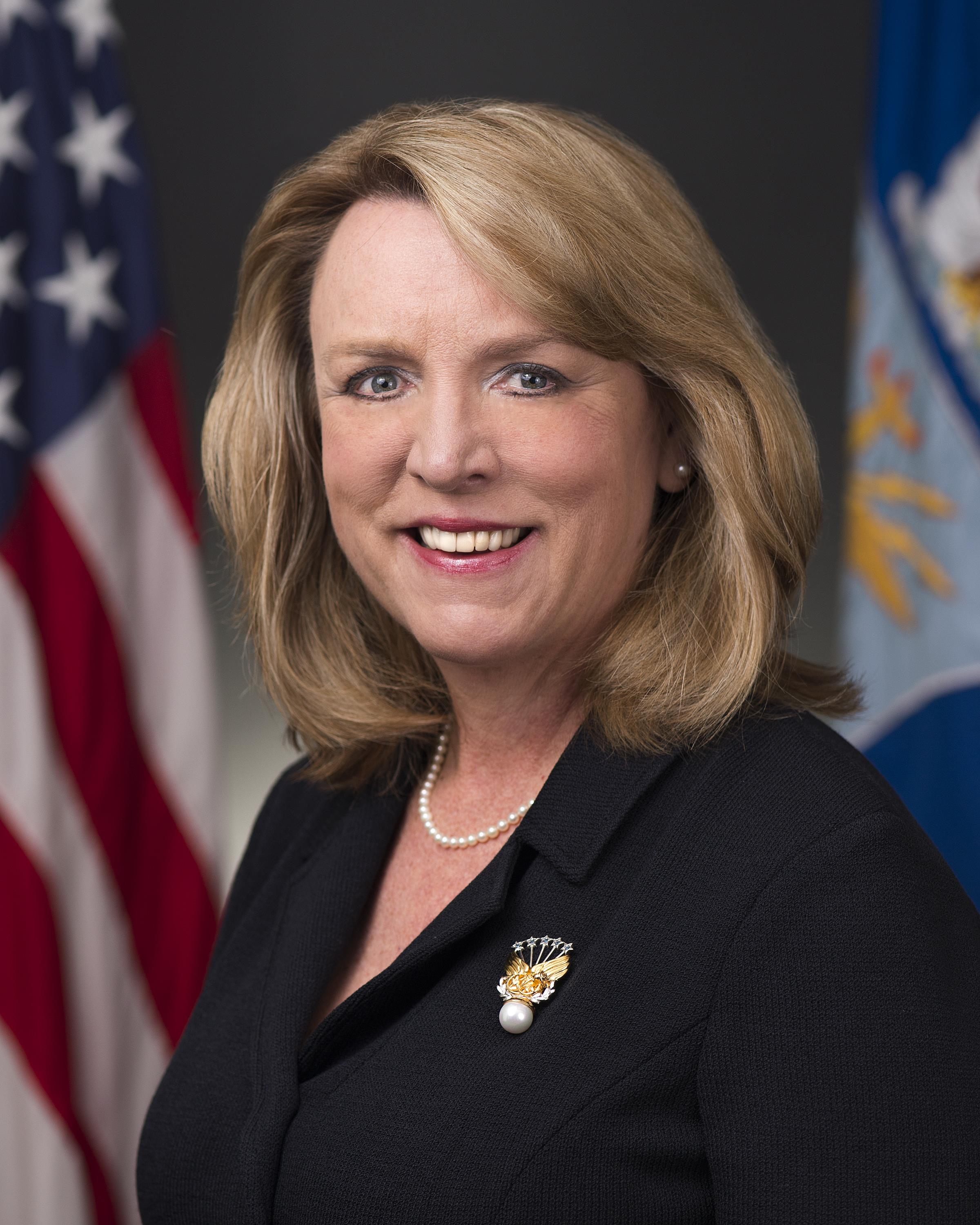
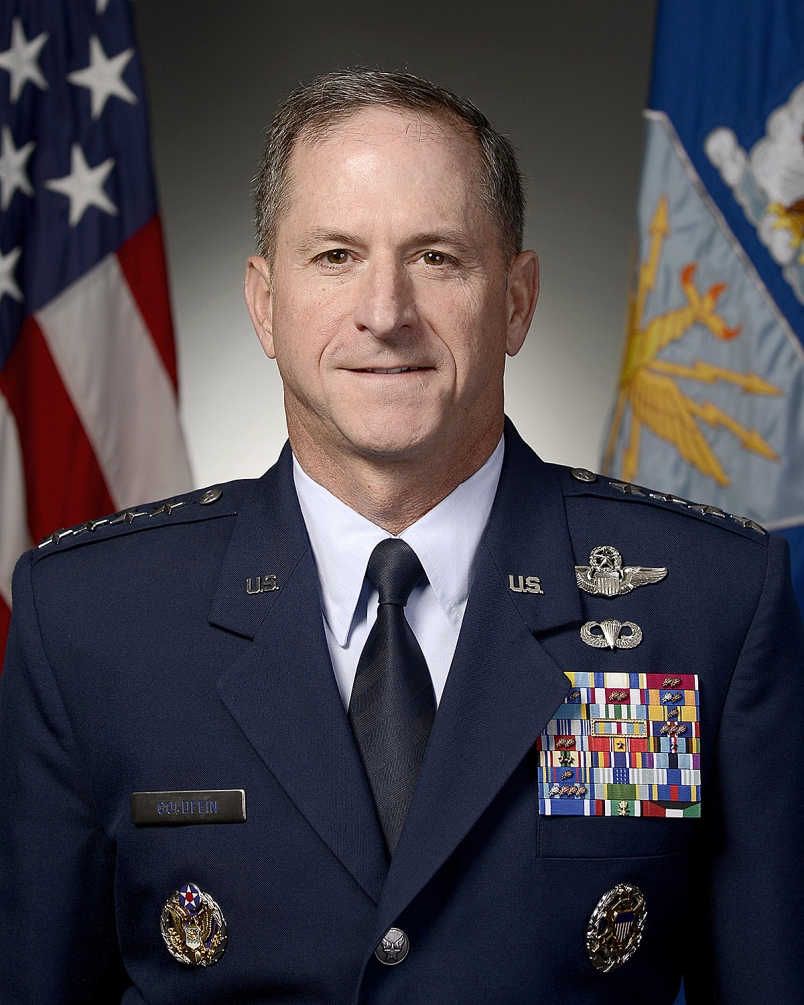
We have heard your concern and frustration on the issue of additional duties that compete with accomplishing our primary Air Force missions. This memo documents initial steps in a longer process that aims to streamline demands on your time. Operational demands are at unprecedented levels, yet our force is smaller than it has ever been. In meeting with Airmen at installations around the globe, we have heard consistently that additional duties assigned at the unit-level affect our ability to focus on core missions, which in turn impacts our readiness.
We recognize these duties originate from a variety of sources, to include federal statutes, Department-wide policy, Air Force Instructions, and Wing and Squadron requirements. In response to your concerns, we are establishing an “Airmen’s Time” task force to tackle and streamline these additional duties, as well as the complete set of requirements, functions, training, and reports that detract from our core missions.
As a first step in this initiative, we recently conducted a review of additional duties that originate in Air Force policy we control. This review sought to establish a framework to address this growing concern among Airmen by assessing each of the 61 duties identified under Air Force Instruction (AFI) 38-206, “Additional Duty Management.” These duties are applied across the Total Force, and are typically not related to the core mission of our units.
Based on this review, we took steps to reduce the burden associated with the list of 61 identified additional duties. These duties are currently required at every unit, where Airmen must be designated and trained to perform these tasks even in organizations where they are not usually needed. The rules provide very little flexibility to Commanders and often compound the burdens associated with required training. In several cases, we were able to eliminate the specific duty across the Air Force. In others, we modified the duty requirement to apply only to those units that require it or consolidated requirements to reduce demand on our Airmen. In other cases, we determined that the work belongs in the Commander Support Staff (CSS) or other work centers that do not require Airmen to be pulled away from their core missions.
Consequently, we are working to re-establish the CSS as a core part of the squadrons that are large enough to warrant them. For squadrons too small to warrant a CSS, those duties should be accomplished by a Group or Wing-level CSS--or not at all if the Commander deems them non-critical. Currently, even in squadrons large enough to have a CSS, the positions are not fully funded. However, as we move forward, we are committed to ensuring CSS requirements are funded and positions filled, as our budget permits. Until the new CSS decisions are implemented and CSS manning is healthy, Commanders are empowered at all levels to consolidate CSS-assigned duties as appropriate, and/or discontinue non-critical duties beyond their ability to resource.
We all must commit to making continuous improvements to reduce excessive demands on Airmen’s time. Accordingly, this task force will institute accountability measures to ensure unit-level practices and Air Force Instructions are correctly revised to reflect these changes no later than 1 October 2016. Second, effective 1 October 2016, the Inspector General shall ensure all unit inspections are conducted in accordance with these revised requirements. Additionally, beginning this fall, Headquarters Air Force will establish a screening process to review new policies in order to identify areas that create additional duties for Airmen in units. The goal is to prevent unchecked growth of these functions in the future.
We also recognize that this effort is just a small, first step. The next phase of our review will focus on computer-based training requirements and the time impacts they have on our Force. It will also focus on duties originating in law and Department of Defense policy, identifying areas that can be eliminated, consolidated, or streamlined. Additionally, the review will focus on how these requirements are impacting our most stressed career fields.
You have our continued commitment to keep a steady focus on this challenge using the process we have now established. Our success in performing missions each day is due to the talent, skill, and professionalism that you provide every day. Thank you for all you do.
Deborah Lee James Dave Goldfein, General, USAF
Secretary of the Air Force Chief of Staff
As the first step in a long-term effort to reduce the burden on Airmen and allow them more time to focus on core missions, the Air Force conducted an assessment of each of the 61 additional duties identified under Air Force Instruction (AFI) 38-206, “Additional Duty Management.” Based on this review, the following duties will be adjusted in a way that reduces the workload for Airmen.
For the programs below realigned to a CSS, squadrons too small to warrant a CSS will have duties either accomplished by a Group or Wing-level CSS--or not at all if the Commander deems them noncritical.
Until the new CSS decisions are implemented and CSS manning is healthy, Commanders are empowered at all levels to consolidate CSS-assigned duties as appropriate, and/or discontinue noncritical duties beyond their ability to resource.
- Awards/Recognition Program Manager: DUTY RE-ASSIGNED. Current Air Force policy requires an Airman at each unit to manage the Awards and Recognition Program. Ensuring Airmen are recognized for their hard work and dedication is important to the morale of the unit and will continue, but this duty will be shifted to the Commander Support Staff (CSS), and will be considered a core task of the CSS.
- Communications Security (COMSEC) Responsible Officer (CRO): DUTY REDUCED. A COMSEC Responsible Officer is designated at the unit level to ensure that authorized unit members are familiar with the proper handling and use of COMSEC material. As a limited number of organizations handle a significant volume of COMSEC, the Air Force-wide requirement to designate an Airman at every unit to serve in this capacity is unnecessary and will be changed. Commanders will have the discretion to determine if a CRO should be designated for units that require it and have flexibility to determine at what unit level the CRO should reside.
- Contamination Control Team Member: DUTY REDUCED. The responsibility to conduct nuclear, chemical, or biological decontamination operations of personnel applies only to a select number of organizations across the Air Force. As such, the Air Force-wide requirement to designate and train a Contamination Control Team Member at every unit is unnecessary and will be changed. Commanders will have the flexibility to determine if this duty is needed at certain units.
- Cybersecurity Liaison (CL): DUTY RE-ASSIGNED. The Air Force-wide requirement to designate a Cybersecurity Liaison at each unit in support of the Wing Cybersecurity Office will be eliminated. In the future, the administrative tasks often associated with this duty, including processing paperwork for network account requests, will be handled by the Commander Support Staff (CSS); all other work associated with this duty will be completed by the Wing Cybersecurity Office.
- Destruction Officer: DUTY ELIMINATED. The requirement to designate a Destruction Officer at the unit level to oversee the destruction of investigative or criminal evidence, and all tasks typically associated with this duty, will be eliminated across the Air Force.
- Functional Area Records Manager (FARM): DUTY ELIMINATED. The Air Force-wide requirement to designate a Functional Area Records Manager (FARM) to manage records at the unit level will be eliminated. Substantial guidance for the proper management and disposition of records for units and individuals exists across the Air Force and Department of Defense. We will continue to strengthen this guidance to ensure we satisfy requirements without requiring Airmen to be trained to manage this process for the unit.
- Government Purchase Card (GPC) Holder/Approving Official: DUTY RE-ASSIGNED. Depending on the size of the organization, units are required to appoint primary, and alternate, GPC approving officials. The responsibility to serve as the primary GPC cardholder will be shifted to the Commander Support Staff (CSS); if the unit is large enough to require alternate cardholders, that duty will continue to be treated as an additional duty, and may require resources outside of the CSS. The task force will continue efforts to streamline the duty to the maximum extent practicable.
- Individualized Newcomer Treatment and Orientation (INTRO) Manager: DUTY ELIMINATED. The INTRO program assists service members with relocating to new assignments or locations. With the exception of the required in-processing actions, which will be performed by the Commander Support Staff (CSS), all other tasks and responsibilities associated with this program will be eliminated across the Air Force.
- Information Technology Equipment Custodian (ITEC): DUTY REDUCED. Currently, Air Force policy requires that an Airman at every unit be designated as an ITEC and be responsible to account for the unit’s IT assets. In an effort to reduce redundancies and garner efficiencies where possible, the ITEC additional duty will be eliminated as an independent requirement and the unit Property Custodian will be responsible to account for IT hardware inventory.
- Lead Organizational Defense Travel System (DTS) Administrator: DUTY RE-ASSIGNED. Depending on the size of the organization, units are require to appoint a single, or multiple, DTS Administrators to assist in reviewing and approving DTS orders and vouchers for their unit members. This is primarily an administrative task that will be shifted to the Commander Support Staff (CSS). The task force will continue efforts to streamline this duty.
- Operational Security (OPSEC) Coordinators: DUTY REDUCED. OPSEC coordinators are appointed at the unit level to oversee and manage an organization’s OPSEC education and training, and to track and mitigate any disclosures of sensitive information. OPSEC coordinators are designated at all unit levels across the Air Force. The requirement to identify an OPSEC coordinator at every unit will be eliminated while granting Commanders greater flexibility in meeting these requirements where needed.
- Records Custodian: DUTY ELIMINATED. The Air Force-wide requirement to designate a Records Custodian to manage records at the unit level will be eliminated. Department and Air Force guidance exists to establish procedures for the proper management and disposition of records at the unit level. We will continue to strengthen this guidance to promote compliance with these requirements without requiring an Airman performing an additional duty.
- Secure Voice Responsible Officer (SVRO): DUTY REDUCED. A SVRO is designated at the unit level to ensure that unit members are able to conduct secure voice communications. Currently, each unit is required to appoint and train an SVRO even though only a limited number of organizations have a requirement to use secure voice communications. Moving forward, the Air Force-wide requirement to designate an Airman at every unit to serve in this capacity will be eliminated. Commanders will have the discretion to determine if a SVRO should be designated and have flexibility to determine at what unit level the SVRO should reside.
- Self-Aid & Buddy Care Monitor/Instructor: DUTY ELIMINATED. Self-Aid & Buddy Care Monitors and Instructors are required to be designated at the unit level, and are responsible to oversee and teach life and limb saving skills to other members within their unit. While this type of training is valuable, it is duplicative of other training provided prior to deployment. To reduce burden on our Airmen, both the monitor and instructor duty will be eliminated across the Air Force. Where applicable, and as needed, contractors will be utilized to provide this training to our Airmen.
- Status of Resources and Training System (SORTS) / E-SORTS Monitor: DUTY REASSIGNED. SORTS is the single, automated reporting system within the DoD that provides senior decision makers with the information regarding the location, assignment, personnel, and equipment at units and organizations across the Armed Forces. As required by law, the monitor function will be retained, but will be shifted to the Commander Support Staff (CSS), and will no longer be required of Airmen outside of the CSS.
- Treaty Escort Official: DUTY REDUCED. The requirement to designate a Treaty Escort Official was duplicative of many of the duties already completed by the Treaty Compliance Officer. As such, this duty has been subsumed by the Treaty Compliance Officer duty.
- Top Secret Control Officer (TSCO): DUTY REDUCED. Currently, an Airman at every unit is required to train and execute a program to manage top secret material as the TSCO. As a limited number of Air Force organizations work with a large volume of top secret material, the Air Force-wide requirement will be eliminated. For those Wings, Groups, or Squadrons that manage a large amount of top secret material, the Commander will have the discretion to determine if a TSCO should be designated, and at what unit level this function should be performed.
- Treaty Compliance Officer: DUTY REDUCED. The Air Force-wide requirement to designate a Treaty Compliance Officer (TCO) as an additional duty within each unit will be eliminated. At those locations that require a permanent TCO to execute regular and reoccurring treaty obligations, assigned manpower from the functional authority, e.g., nuclear, will continue to perform the mission. At those locations that do not receive a resourced position because of limited need for a TCO, the installation commander or their designee will be the single point of contact at the installation to interface with the functional authority on treaty compliance matters.
- Trusted Agent / Unit Drug Demand Reduction Program Monitor: DUTY RE-ASSIGNED. The requirement to designate an Airman at every unit to serve as a Trusted Agent and monitor the unit’s Drug Demand Reduction Program will be eliminated. Instead, this responsibility will be shifted to the Commander Support Staff (CSS) and be considered a core task of the CSS.
- Unit Aerospace Expeditionary Force Reporting Tool (ART) Monitor: DUTY REASSIGNED. Currently, an Airman at every unit is required to be designated as the Unit ART Monitor, responsible to report on a Unit Type Code’s ability to perform its mission capabilities at any given time. Moving forward, this responsibility will be shifted to the Commander Support Staff (CSS) and be considered a core task of the CSS.
- Unit Deployment Manager (UDM): DUTY REASSIGNED. Current policy requires a designated UDM at every unit to liaise between a number of stakeholders to ensure that unit personnel are ready to deploy. Moving forward, this responsibility will be shifted to the Commander Support Staff (CSS) and be considered a core task of the CSS.
- Unit Personal Wireless Communications Systems Equipment Custodian (PEC): DUTY REDUCED. Currently, Air Force policy requires that an Airman at every unit be designated as the PEC and be responsible for the accountability of the unit’s Personal Wireless Communications Systems assets. At most units, this requirement is redundant and requires unnecessary training and time to perform this duty. The PEC additional duty will be eliminated across the Air Force. The unit Property Custodian, responsible for all general property inventory and asset management, will be responsible to account for these assets where applicable.
- Unit Public Affairs Representative: DUTY ELIMINATED. The requirement to designate a Unit Public Affairs Representative to liaise with the Wing and higher headquarters will be eliminated across the Air Force. Instead, the Wing Public Affairs Office will work with unit leadership, as required, in our mission to communicate with the media and the public.
- Unit Security Manager: DUTY RE-ASSIGNED. At every unit across the Force, it is required that an Airman be designated as the Unit Security Manager. This Airman is responsible to perform a number of administrative duties, to include verifying clearance levels of unit members and tracking the status of clearance actions. This responsibility will be shifted to the Commander Support Staff (CSS) and be considered a core task of the CSS.
- Unit Tax Representative (Advisor): DUTY ELIMINATED. Currently, each unit has the requirement to designate a Unit Tax Representative to assist unit members when preparing and filing their income tax. While this duty is seasonal, it often becomes akin to a full-time job during tax season. The requirement to designate and train an Airman to perform this function as an additional duty will be eliminated across the Air Force.
- Unit Training Manager (UTM): DUTY REASSIGNED. The Air Force-wide requirement to designate an Airman at every unit to serve as the Unit Training Manager will be eliminated. Instead, this duty will be shifted to the Commander Support Staff (CSS) and be considered a core task of the CSS.
- Unit Voting Assistance Counselor (UVAC): DUTY RE-ASSIGNED. The Air Force-wide requirement to designate an Airman at every unit to serve as a UVAC and help members of the unit with the voting registration and election process will be eliminated. To meet these requirements, a representative at the Air Force Personnel Center will serve as the central Voting Assistance Counselor and will work with the Airman and Family Readiness Centers across installations to provide the necessary information and assistance to Airmen. No changes to this program will be made until January 1, 2017, after the 2016 elections.
- Vehicle Control Officer (VCO): DUTY REDUCED. The VCO is responsible to oversee maintenance on all government vehicle matters. The Air Force-wide requirement to designate an Airman at every unit to serve in this capacity is unnecessary and will be changed. Commanders will have discretion to determine whether a VCO is needed in those units with a large number of vehicles and at what level, e.g., squadron, wing, etc. the VCO should be assigned.
- Web Page Maintainer: DUTY ELIMINATED. The requirement for an Airman at every unit to be designated as a Web Page Maintainer for the unit’s publicly available website will be eliminated across the Air Force.
Security Guard Position Opening
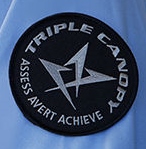 https://triplecanopy.hua.hrsmart.com/hr/ats/Posting/view/881
https://triplecanopy.hua.hrsmart.com/hr/ats/Posting/view/881
Internal Roving Security Guard: - (SSA.6)
Location -- UNDISCLOSED, AF (Primary)
Employment Type -- Intermittent
Education -- High School or Equivalent
Category -- Security
Job Description:
Performs internal roving guard services and must possess the ability to react to force protection threats. Armed roving security patrol personnel shall possess the following qualifications and be physically able to perform all duties.
Job Requirements:
· Minimum 23 years of age.
· Shall be fluent in English speaking, reading and writing
· Shall be a U.S. citizen
· Possess an active U.S. Secret Clearance
· Possess a Military background in combat arms, having worked in the capacity of Army Military Occupational Specialty series; 11B Infantry, 18 Special Forces, 31B Military Police, 19D Calvary Scout; USMC Military Occupational Specialty 0372 MARSOC, 0311/0331 Specialist, 5326 SEAL; 5352 SWCC; or Air Force Occupational Specialty AFSC 3POX1 Security Forces, AFSC 1T2X1 Para-Rescue.
· Must have received an honorable discharge as verified by a form DD Form 214 (U.S. Military). Personnel who have been discharged with characterization of “General under other than honorable’, “Bad Conduct”, or “Dishonorable” are disqualified from this position.
· Must be able to qualify on primary U.S. military weapons and crew-served weapons.
· Possess a valid U.S. driver’s license.
· Possess a valid U.S. Tourist Passport
· Able to become license on military tactical vehicles
· Able to physically perform internal security guard services, at any potential internal security posting for up to 12 hours (not to exceed 72 hours a week), often in austere conditions to include extreme heat, cold, wind, dust, rain or snow, while donning all required personal protective gear.
Direct questions to: Darrell Eplee, at This email address is being protected from spambots. You need JavaScript enabled to view it.
Ready for anything at KAFB
By Charles D. Brunt / Albuquerque Journal Staff Writer, Monday, August 8th, 2016
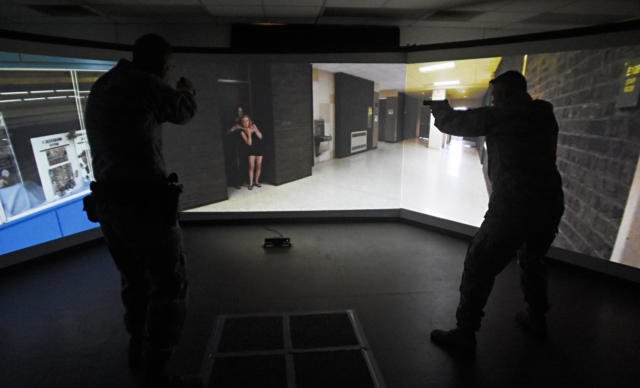
Using a training system called the Multiple Interactive Learning Objectives simulator, or MILO, Staff Sgt. Brandon Gomez, left, and Tech. Sgt. Justin Jacobsen of the 377th Security Support Squadron at Kirtland Air Force Base participate in an exercise involving a gunman in a school. (Dean Hanson/Albuquerque Journal)
Copyright © 2016 Albuquerque Journal
Tech Sgt. Justin Jacobsen and Staff Sgt. Brandon Gomez, both of whom are with the 377th Security Support Squadron at Kirtland Air Force Base, stopped a 72-year-old man in a pickup truck for speeding on a dirt road. The man told the airmen that his driver’s license was in a duffel bag in the bed of his truck.
But when he reached into the back of the truck, he pulled out a pistol, whirled around and aimed it at the cops – who opened fire with their 9mm Baretta pistols, sending the old boy to his maker.
Fortunately for the elderly driver, the encounter last week unfolded during a training session on the base’s new high-tech MILO simulator.
MILO, or the Multiple Interactive Learning Objectives simulator, is proving to be an invaluable training tool for the more than 600 security personnel who keep the sprawling 51,558-acre base safe and secure, said Jacobsen and Gomez, instructors in charge of training law enforcement and security personnel at Kirtland.
Imagine an interactive, room-sized, IMAX-like theater where police trainees walk through stunningly realistic scenarios – ranging from a seemingly routine traffic stop to confronting multiple shooters inside a school – and you’ll have some idea of what MILO is all about.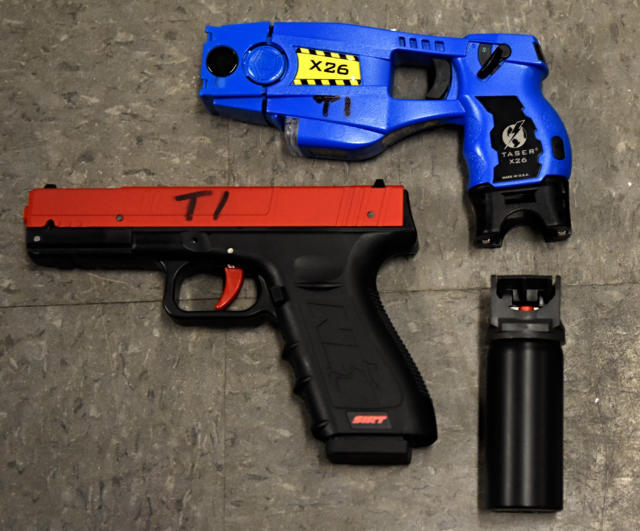
Weapons available for training exercises in Kirtland Air Force Base’s Multiple Interactive Learning Objectives simulator include a handgun, a Taser and pepper spray. (Dean Hanson/Albuquerque Journal)
But as the TV huckster says, “That’s not all!”
The system is interactive and seamlessly responds to, and records, the trainees’ actions. Using laser inserts that fit into the trainees’ actual weapons – ranging from pepper spray and a Taser to handguns and assault rifles – the system times their reactions, shows where their bullets hit and, in a worst-case scenario, tells them the bad guy won the encounter.
Kirtland is the only active-duty Air Force base that has this particular system, known as the MILO Range Theater 300. The $170,000 system was installed in January, and more than 500 of the base’s roughly 600 security personnel have already trained on it. Some of them perform police duties, and others protect unclassified and classified “base assets.”
Jacobsen, who’s in charge of training security forces, said the squadron provides mandatory annual training as well as use-of-force training for all of the 377th Security Forces, an Army Reserve unit and a maintenance squadron.
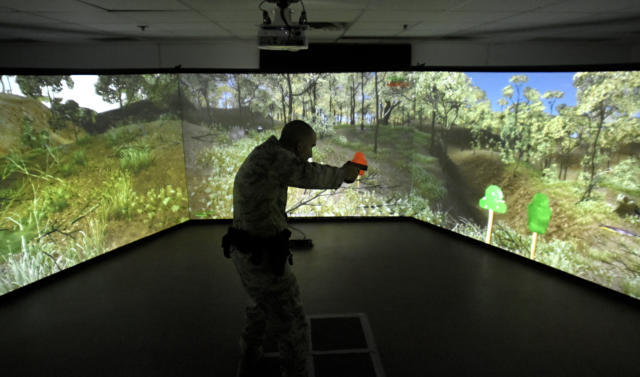
Staff Sgt. Brandon Gomez of the 377th Security Support Squadron at Kirtland Air Force Base participates in a training exercise on the Multiple Interactive Learning Objectives simulator. (Dean Hanson/Albuquerque Journal)
The training includes classroom instruction, time on the simulator and testing to determine a trainee’s proficiency. Each trainee typically goes through two to four scenarios on the simulator during training.
“There are more than 800 scenarios, and within those scenarios are different options the instructors can control, so actually you get 1,000-plus different scenarios,” Jacobsen said.
Last week, Jacobsen and Staff Sgt. Brandon Gomez, who handles law enforcement training, demonstrated MILO’s capabilities by going through a series of scenarios on the simulator: the aforementioned traffic stop with the 72-year-old man; a domestic violence call; a group of active shooters inside a school; a pickup truck that runs through a base gate; and a despondent man armed with a handgun.
When trainees go into the simulator, they have only minimal information about what they might encounter – much like they’d get from a radio dispatcher.
“We’ll tell them what they’re responding to, but for the most part, it’s up to the trainee to react to the situation,” Jacobsen said.
The goals are to ensure that each trainee uses the minimum amount of force necessary to defuse the various situations, to improve their reaction times and, above all, to make sure they and innocent bystanders survive the encounters.
“This gives us the opportunity for airmen to make mistakes, where it’s not going to cost them their lives, or possibly someone else’s,” Gomez said.
Out in the real world, he noted, a single mistake can be fatal.
“Once the incident is over, we’re able to go back, walk through (the simulator scenario) step by step with the trainee,” he said. “We can show them what they should have been looking for, what they might have missed.”
Prior MILO trainees had a rudimentary single-screen simulator that was “basically a shoot/no-shoot scenario,” the instructors said. “That was the Atari, and this is the Xbox One,” Jacobsen said.
The scenarios can be shockingly realistic, complete with blood spatters, foul-mouthed perpetrators and well-meaning but distracting bystanders.
“It can get pretty graphic,” Jacobsen noted. “In one of our scenarios, if you don’t take action, the perpetrator shoots the victim and you’ll get blood spatter on the screen.”
The instructors are now customizing many of the scenarios by recording locations on Kirtland and integrating them into the simulator training. The gate-runner scenario – which involves a passenger jumping out of a truck with an assault weapon – features the base’s Eubank Gate.
Jacobsen said he hopes airmen who use the simulator will realize how quickly routine interactions can turn deadly, and how such training can ensure “the best outcome” in any situation.
“I want these airmen to come in here and get the best training they can to ensure not only that they make themselves safe, but they keep the individuals they’re responding safe as well,” he said
Moody airmen receive Bronze Star
By Terry Richards, 10 July 2016
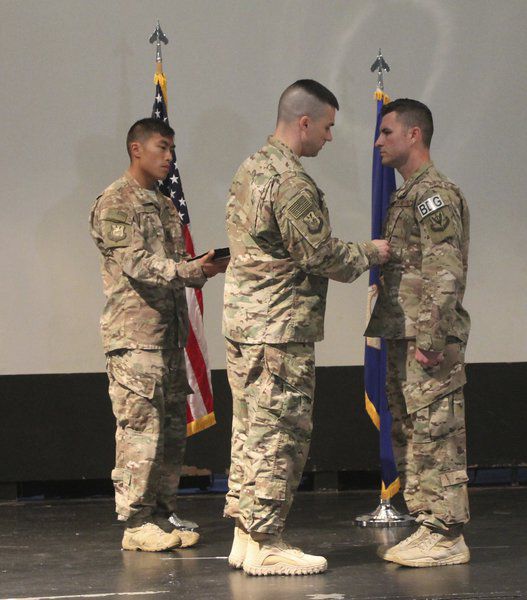
Col Kevin Walker pins a medal on SSgt Bradley Mock at Moody AFB. Photo by Terry Richards, The Valdosta Daily Times
MOODY AIR FORCE BASE — Two sergeants at Moody AFB were honored for valor Friday for their actions dealing with a suicide bomber in Afghanistan last year.
Master Sgt. Aaron Frederick and Staff Sgt. Bradley Mock, both with the 824th Base Defense Squadron, earned the Bronze Star with Valor, the Air Force Combat Action Medal and the Purple Heart at a ceremony at the base’s Hoffman Auditorium.
Their families and hundreds of Moody personnel watched as Col. Kevin Walker pinned the medals on the pair.
“We overuse certain words, and when you overuse these words, their meanings become degraded,” Walker said. “I’m going to use a word I don’t very often say ... the word ‘hero.’”
Frederick was a patrol leader near Bagram Airfield in Afghanistan on Dec. 21, according to the citation for his Bronze Star.
His patrol of 13 men was six kilometers away from the base when they were targeted by a Taliban suicide bomber on a motorcycle. The biker stopped only 15 feet away.
Frederick lunged toward the bomber just as he detonated explosives, killing six airmen and wounding five others, the citation said.
Despite receiving second-degree burns, Frederick took control of the scene, regrouping survivors and re-establishing security. He coordinated a landing zone for medical evacuation “despite excruciating pain,” and refused medical attention until he knew everyone else was accounted for, according to the citation.
Mock was a radiotelephone operator in the same patrol and was knocked out by the bomb’s blast, according to the citation for his Bronze Star. He regained consciousness after a few minutes and, despite facial lacerations and a concussion, re-established communications and summoned help while providing medical aid to injured teammates.
He also secured important equipment and intelligence, according to the citation.
After the presentation of the medals, the two men and their families greeted hundreds of people in a receiving line.
The Bronze Star is awarded for heroism or meritorious achievement in a combat zone. When awarded for valor, a “V” is added to the award.
The Air Force Combat Action Medal honors participation in air or ground combat. The wearer must have either been under fire while working in an unsecured area or defending a base while under fire.
The Purple Heart is given to servicemen who are wounded or killed in action. The medal can be traced back to an order of Gen. George Washington in 1782, when it was called the Badge of Military Merit.
Terry Richards is senior reporter at The Valdosta Daily Times.
Page 44 of 50


